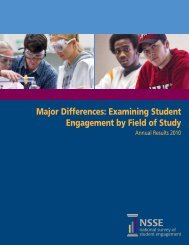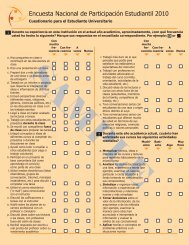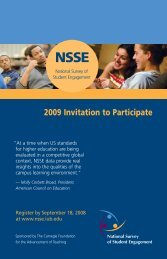Conceptual Framework and Overview of Psychometric Properties
Conceptual Framework and Overview of Psychometric Properties
Conceptual Framework and Overview of Psychometric Properties
Create successful ePaper yourself
Turn your PDF publications into a flip-book with our unique Google optimized e-Paper software.
Interpreting The Meaning <strong>of</strong> EngagementItems: Results from Student Focus GroupsThe psychometric analyses show that the vastmajority <strong>of</strong> items on The College StudentReport are valid <strong>and</strong> reliable <strong>and</strong> haveacceptable kurtosis <strong>and</strong> skewness indicators.What cannot be demonstrated from suchpsychometric analyses is whether respondentsare interpreting the items as intended by theNSSE Design Team <strong>and</strong> whether students=responses accurately represent their behaviors<strong>and</strong> perceptions. That is, even whenpsychometric indicators are acceptable,students may be interpreting some items tomean different things.It is relatively rare that survey researchers gointo the field <strong>and</strong> ask participants to explainthe meaning <strong>of</strong> items <strong>and</strong> their responses.However, because <strong>of</strong> the importance <strong>of</strong> theNSSE project, we conducted focus groups <strong>of</strong>first-year <strong>and</strong> senior students during March<strong>and</strong> April 2000 at eight colleges <strong>and</strong>universities that participated in NSSE 2000.The schools included four private liberal artscolleges (including one woman=s college) <strong>and</strong>four public doctoral-granting universities.Between three <strong>and</strong> six student focus groupswere conducted on each campus. The number<strong>of</strong> students participating in the groups rangedfrom 1 to 17 students, for a total <strong>of</strong> 218student participants. More women (74%) <strong>and</strong>freshmen (52%) participated than men (26%)<strong>and</strong> seniors (48%). Approximately 37% werestudents <strong>of</strong> color. Although there was notenough time to discuss every item during eachfocus group, every section <strong>of</strong> the instrumentwas addressed in at least one group on eachcampus.In general, students found The Report to beclearly worded <strong>and</strong> easy to complete. A fewitems were identified where additional claritywould produce more accurate <strong>and</strong> consistentinterpretations. For example, the Anumber <strong>of</strong>books read on your own@ item confused somestudents who were not sure if this meantreading books for pleasure or readings tosupplement those assigned for classes. Thisitem is an illustration <strong>of</strong> a h<strong>and</strong>ful <strong>of</strong> itemswhere students suggested that we provideadditional prompts to assist them inunderst<strong>and</strong>ing questions. However, studentsgenerally interpreted the item responsecategories in a similar manner. The meaningsassociated with the response sets variedsomewhat from item to item, but students=interpretations <strong>of</strong> the meaning <strong>of</strong> the itemswere fairly consistent. For example, whenstudents marked Avery <strong>of</strong>ten@ to the itemAasked questions in class or contributed toclass discussions@ they agreed that thisindicated a daily or during every classmeeting. When answering the Amade a classpresentation@ item, students told us that Avery<strong>of</strong>ten@ meant about once a week.The information from student focus groupsallows us to interpret the results with moreprecision <strong>and</strong> confidence. This is because thefocus group data indicated that studentsconsistently interpreted items in a similar way<strong>and</strong> that the patterns <strong>of</strong> their responsesaccurately represent what they confirm to bethe frequency <strong>of</strong> their behavior in variousareas. We also have a better underst<strong>and</strong>ing <strong>of</strong>what students mean when they answer variousitems in certain ways. In summary, we areconfident that student self-reports about thenature <strong>and</strong> frequency <strong>of</strong> their behavior arereasonably accurate indicators <strong>of</strong> theseactivities. For additional detail about the focusgroup project look at the Ouimet, Carini, Kuh,<strong>and</strong> Bunnage (2001) paper on the NSSEwebsite.Cognitive Testing InterviewsWe used information from the focus groups<strong>and</strong> psychometric analyses to guide revisionsto the 2001 version <strong>of</strong> The College StudentReport. We also worked closely with surveyexpert, Don Dillman to redesign the<strong>Framework</strong> & <strong>Psychometric</strong> <strong>Properties</strong>Page 21 <strong>of</strong> 26



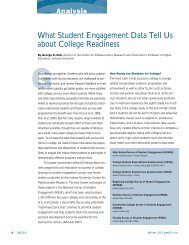

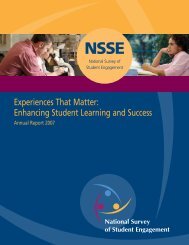
![Cuestionario para el Estudiante Universitarioâ[consent] - NSSE](https://img.yumpu.com/41728892/1/190x245/cuestionario-para-el-estudiante-universitarioaconsent-nsse.jpg?quality=85)
